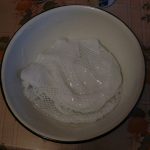How to starch things at home
The question of how to starch things at home usually arises unexpectedly. Since in the current conditions things are processed in this way quite rarely. Usually they are simply washed and sometimes ironed.

Many people do not even know about this method of processing fabric. But sometimes situations arise when it is simply necessary to starch a thing.
Why do you need to starch the fabric
Starch has been used for processing things for many centuries. Today this method is undeservedly forgotten, as things have become cheaper, and the rhythm of life has become faster. Because of this, the meaning in the long processing of linen and clothes was lost.

However, tissue starching has a number of advantages; it is no coincidence that it has been used for many centuries:
- Extends service life.
- Things wrinkle less and look neater.
- They retain their shape better.
- They look more solemn.
- Less dirty.
What makes things last longer after starching? With this treatment, the thing is rinsed in water in which starch is dissolved. Thanks to this, the substance penetrates into the fibers of the fabric and forms a protective coating on them. It is because of such a coating that it is more difficult for dirt to get into the fibers, and they themselves are less rubbed off.

This increases the density and rigidity of the material. Due to the fact that the density increases, things wrinkle less. And the increase in stiffness allows them to better keep their shape. Starchy collars easily keep their neat appearance until the next wash.
Thus, starching allows you to wash things less often and iron them less often, which significantly saves time even with a machine wash.
Important! Starch bleaches things. Therefore, the shirts after processing look boiling white. Starch returns white color to yellowed things. At the same time, starch does not spoil the thing, like many chemical bleaches.
Basic ways
There are several known methods of processing a material using starch. Different methods allow you to achieve different stiffness of the material and therefore are used depending on the purpose of the product.

A little stiffness is required for linen or clothes made of delicate fabrics: women's blouses, scarves, dresses.
The medium hardness method is required for processing men's shirts, shirts, napkins, curtains or tablecloths. In this case, the starch gives the thing a rigid shape, for example, collars, but at the same time retains the properties of the fabric to bend.

The rigid method is suitable for cases when the material needs to be given a specific shape. That is, to make the fabric stand. It is used to make artificial flowers, decorative items from fabrics, knitwear, lace.

When asking how to starch lace at home, it is the tough method that is used. Using this method, you can easily make a fluffy crinoline petticoat or a children's crown from fabric or lace.
Important! The higher the stiffness of the starch, the higher the protective properties of this coating.

Different types of starch are used for processing fabrics:
- Rice bleaches things best.
- Corn is less thick and therefore less stiff than other types.
- Potato. It is the cheapest and therefore the most common.
The gentle way
To understand how to properly starch your laundry, you must first study the instructions for the gentle method. Consistency calculation: 1 small teaspoon of starch per liter of water. Dilute starch very carefully. This substance sticks together easily in water. Therefore, at first, it is slowly dissolved in a glass of cold water.

You do not need to fill in the whole teaspoon at once, otherwise lumps will form. It is necessary to gently shake off the starch on the surface of the water and then stir. After the solution is ready, you need to boil clean water in a saucepan.

When it boils, reduce the heat and gently pour the starch into the container with a thin stream. In this case, it is necessary to constantly stir the solution. Then the fire should be turned off and wait for the agent to cool down to a temperature of 40-45C. This is the hot water temperature.
It is necessary to immerse the thing in such a solution, rinse it slightly in it so that the product is distributed over the fibers, pull it out and squeeze it out. After that, the thing must be dried.
Advice. It is most convenient to starch the item in the basin, however, for this you will have to pour the solution. Some housewives use a galvanized bucket. This avoids overflowing liquid.
Average way
The average method of how to starch fabric at home according to technology does not differ from the soft method. The main difference here is consistency.

The proportions of the composition of medium hardness will be as follows: 1 standard tablespoon without top per 1 liter of water. It is also necessary to stir the substance very gently in a glass of water and then pour it into heated water.

Things need to be dipped in a basin or bucket of solution and kept there for 3-5 minutes. In this case, it is necessary to slightly stir the composition. This is necessary in order for the starch to better penetrate into the fibers and be absorbed into them.
Advice. In a soft and hard way, things can be starch in the washing machine. To do this, pour the starch solution into the rinse aid compartment. When rinsing, the starch will be added to the water drum.
The hard way
How to starch fabric at home in a tough way should be taken apart in particular detail. Since this is the most difficult method of fabric processing. It involves not only impregnation with a solution, but also shaping things.
The classic method of preparing a solution: 2 tablespoons of ordinary spoons per 1 liter of water. The solution is prepared in the usual way.

Option of a solution with borax. A solution with starch is also prepared. 1 teaspoon of borax is dissolved in a glass of boiling water and then added to the starch solution. After preparation, the mixture is infused for 20 minutes. After that, the thing can be starch.

You can starch a thing in different ways. The product can be dipped into the solution, let the solution soak. For this, the thing must be kept in it for about 20 minutes. This is done with crinolines, decorative elements - that is, products that must be completely starched hard.

After that, they are pulled or fixed on a certain shape. When the substance solidifies, they will retain this shape. Starching of individual small parts is also possible: collars, cuffs. Then there is no need to dip the thing into the solution. You can apply the product with a wide brush.
Starch-free methods
To impart rigidity to synthetic fabrics, starch is not used, since it does not linger on such fibers. To do this, you can use other substances:

Granulated sugar. The syrup is made from 200 g of sugar and 100 ml of water. Then the product is applied with a brush to the product.
Important! This method is not applicable in summer with open windows, as the syrup will attract flies and wasps that will land on the thing.
Gelatin not only stiffens things, but also reduces the generation of static electricity. It also gives the fabric a slight sheen, which is why it is often used for satin.

A solution of the substance is prepared at the rate of 4 tablespoons per liter of water. When the gelatin dissolves and swells, it is slightly warmed up. Then the product is immersed in water for several minutes.
PVA glue or silicate glue. These substances are not used for clothing. But they can give a rigid shape to the decorative elements, so that the fabric stands. Calculation of the solution: 100 ml of glue per glass of water. The substance is applied to the fabric with a brush. Then the fabric is squeezed and pulled over the mold.

In addition to home remedies, professional chemicals are also used. They are all machine washable and hand washable.
The nuances of starching different types of fabrics
Cotton and linen are the easiest to process in this way.

Therefore, you need to start your tests in this art with these fabrics.
- It is recommended to starch chiffon, organza and various types of silk only in a gentle way. In this case, you should not keep the products in solution for a long time.
- Lace is usually treated with a medium to hard grout. Rice starch is best suited for this, as it whitens things the most. Starching lace requires subtlety of work, since the composition must be evenly distributed over the product. Therefore, the use of a brush for application requires care and accuracy.
- Tulle is also very neat to starch. It is treated only with a weakly concentrated solution. In this case, they are placed in the liquid for only 2-3 seconds.

Is it possible to starch colored things
Colored items made from natural materials are processed in a soft way. However, it is important to make sure that the product does not fade. Products of bright colors will look beautiful and neat after such a procedure.

It is better not to starch products painted in dark or black colors. The fact is that the substance can leave white streaks on the fabric, which will only spoil the appearance.
Do not starch items with embroidery with floss threads. The starch will glue these threads together, and the embroidery will not look aesthetically pleasing and clumsy.
What can not be starch
Despite the fact that starching is useful for the operation of a thing, some products cannot be processed this way.

This includes items such as:
- Underwear. Starchy materials do not allow air to pass through. Because of this, it will be stuffy and hot in such underwear.
- Summer clothes are not treated this way for the same reason. Otherwise it will be too hot in summer. Moreover, in such clothes the body sweats more.
- Kids' things. Due to the low ability to pass air, such things can provoke prickly heat or eczema in a child.
- Synthetics do not starch, as its fibers do not absorb this substance.

All other things can be processed. This will make them more neat and less demanding to wear.
Video: a quick and easy way to starch napkins








